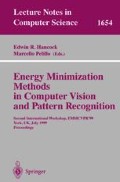Abstract
We study the dynamical properties of two new relaxation labeling schemes described in terms of differential equations, and hence evolving in continuous time. This contrasts with the customary approach to defining relaxation labeling algorithms which prefers discrete time. Continuous-time dynamical systems are particularly attractive because they can be implemented directly in hardware circuitry, and the study of their dynamical properties is simpler and more elegant. They are also more plausible as models of biological visual computation.We prove that the proposed models enjoy exactly the same dynamical properties as the classical relaxation labeling schemes, and show how they are intimately related to Hummel and Zucker’s now classical theory of constraint satisfaction. In particular, we prove that, when a certain symmetry condition is met, the dynamical systems’ behavior is governed by a Liapunov function which turns out to be (the negative of) a well-known consistency measure. Moreover, we prove that the fundamental dynamical properties of the systems are retained when the symmetry restriction is relaxed. We also analyze the properties of a simple discretization of the proposed dynamics, which is useful in digital computer implementations. Simulation results are presented which show the practical behavior of the models.
Access this chapter
Tax calculation will be finalised at checkout
Purchases are for personal use only
Preview
Unable to display preview. Download preview PDF.
References
D. H. Ballard and C. M. Brown, Computer Vision. Prentice-Hall, Englewood Cliffs, NJ, 1982.
Q. Chen and J. Y. S. Luh. Ambiguity reduction by relaxation labeling. Pattern Recognition, 27(1):165–180, 1994.
Q. Chen and J. Y. S. Luh. Relaxation labeling algorithm for information integration and its convergence. Pattern Recognition, 28(11):1705–1722, 1995.
A. Cichoki and R. Unbehauen. Neural Networks for Optimization and Signal Processing. Wiley, 1993.
R. L. Devaney. An Introduction to Chaotic Dynamical Systems. Addison Wesley, 1989.
M. W. Hirsch and S. Smale. Differential Equations, Dynamical Systems, and Linear Algebra. Academic Press, New York, 1974.
J. J. Hopfield. Neurons with graded response have collective computational properties like those of two-state neurons. Proc. Natl. Acad. Sci. USA, 81:3088–3092, 1984.
R. A. Hummel and S. W. Zucker. On the foundations of relaxation labeling processes. IEEE Trans. Pattern Anal. Machine Intell., 5:267–287, 1983.
J. Kittler and J. Illingworth. Relaxation labeling algorithms-A review. Image Vision Comput., 3:206–216, 1985.
S. Z. Li, W. Y. C. Soh, and E. K. Teoh. Relaxation labeling using augmented Lagrange-Hopfield method. Pattern Recognition, 31(1):73–81, 1998.
S. Peleg and A. Rosenfeld. Determining compatibility coefficients for curve enhancement relaxation processes. IEEE Trans. Syst. Man Cybern., 8:548–555, 1978.
M. Pelillo. The dynamics of nonlinear relaxation labeling processes. J. Math. Imaging Vision, 7(4):309–323, 1997.
M. Pelillo and A. M. Fanelli. Autoassociative learning in relaxation labeling networks. Pattern Recognition Lett., 18(1):3–12, 1997.
M. Pelillo and M. Refice. Learning compatibility coefficients for relaxation labeling processes. IEEE Trans. Pattern Anal. Machine Intell., 16(9):933–945, 1994.
A. Rosenfeld, R. A. Hummel, and S. W. Zucker. Scene labeling by relaxation operations. IEEE Trans. Syst. Man Cybern., 6(6):420–433, 1976.
A. J. Stoddart, M. Petrou, and J. Kittler. On the foundations of probabilistic relaxation with product support. J. Math. Imaging Vision, 9:29–48, 1998.
A. Torsello and M. Pelillo. Continuous-time relaxation labeling processes. Pattern Recognition, submitted.
J. W. Weibull, EvolutionaryGam e Theory. MIT Press, Cambridge, MA, 1995.
S. W. Zucker, A. Dobbins, and L. Iverson. Two stages of curve detection suggest two styles of visual computation. Neural Computat., 1:68–81, 1989.
Author information
Authors and Affiliations
Editor information
Editors and Affiliations
Rights and permissions
Copyright information
© 1999 Springer-Verlag Berlin Heidelberg
About this paper
Cite this paper
Torsello, A., Pelillo, M. (1999). Continuous-Time Relaxation Labeling Processes. In: Hancock, E.R., Pelillo, M. (eds) Energy Minimization Methods in Computer Vision and Pattern Recognition. EMMCVPR 1999. Lecture Notes in Computer Science, vol 1654. Springer, Berlin, Heidelberg. https://doi.org/10.1007/3-540-48432-9_18
Download citation
DOI: https://doi.org/10.1007/3-540-48432-9_18
Published:
Publisher Name: Springer, Berlin, Heidelberg
Print ISBN: 978-3-540-66294-5
Online ISBN: 978-3-540-48432-5
eBook Packages: Springer Book Archive

